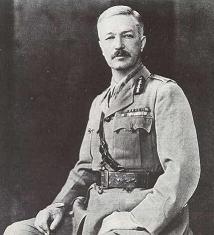
Back ريجينالد دير ARZ Reginald Dyer German Reginald Dyer Spanish رجینالد دایر Persian Reginald Dyer Finnish Reginald Dyer French Briogáidire-Ghinearál Reginald Dyer Irish רג'ינלד דייר HE रेजिनाल्ड एडवर्ड डायर Hindi ರೆಜಿನಾಲ್ಡ್ ಡೈಯರ್ Kannada
Reginald Dyer | |
|---|---|
 Dyer c. 1919 | |
| Born | 9 October 1864 Murree, Punjab, British India (now Pakistan) |
| Died | 23 July 1927 (aged 62) Long Ashton, Somerset, England |
| Allegiance | British Empire |
| Service/ | |
| Years of service | 1885–1920 |
| Rank |
|
| Commands held | |
| Battles/wars | |
| Awards | |
| Spouse(s) | Frances Anne Trevor Ommaney (m. 1888) |
| Children |
|
Colonel Reginald Edward Harry Dyer, CB (9 October 1864 – 23 July 1927) was an officer of the Bengal Army and later the newly constituted British Indian Army. His military career began in the regular British Army but he soon transferred to the presidency armies of India.
As a temporary brigadier-general,[1] he was responsible for the Jallianwala Bagh massacre that took place on 13 April 1919 in Amritsar (in the province of Punjab). He has been called "the Butcher of Amritsar",[2] because of his order to fire on a large gathering of people. The official report stated that this resulted in the killing of at least 379 people and the injuring of over a thousand more.[3] Some submissions to the official inquiry suggested a higher number of deaths.[4]
Dyer was removed from duty and widely condemned both in Britain and India, but he became a celebrated hero among some with connections to the British Raj.[5] Some historians argue the episode was a decisive step towards the end of British rule in India.[6]
- ^ Cite error: The named reference
temp-bgwas invoked but never defined (see the help page). - ^ Collett 2006.
- ^ Ferdinand Mount, "They would have laughed", in London Review of Books dated 4 April 2019, Vol. 41, No.7, pp. 9–12
- ^ Collett 2006, p. 263.
- ^ Derek Sayer, "British Reaction to the Amritsar Massacre 1919–1920," Past & Present, May 1991, Issue 131, pp. 130–164
- ^ Bond, Brian (October 1963). "Amritsar 1919". History Today. Vol. 13, no. 10. pp. 666–676.
© MMXXIII Rich X Search. We shall prevail. All rights reserved. Rich X Search